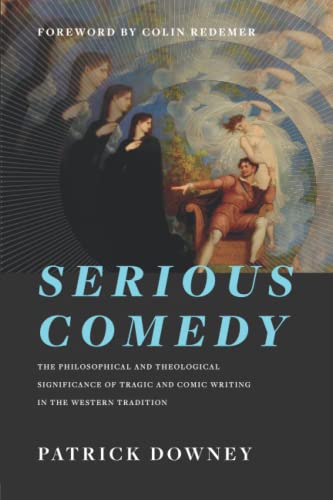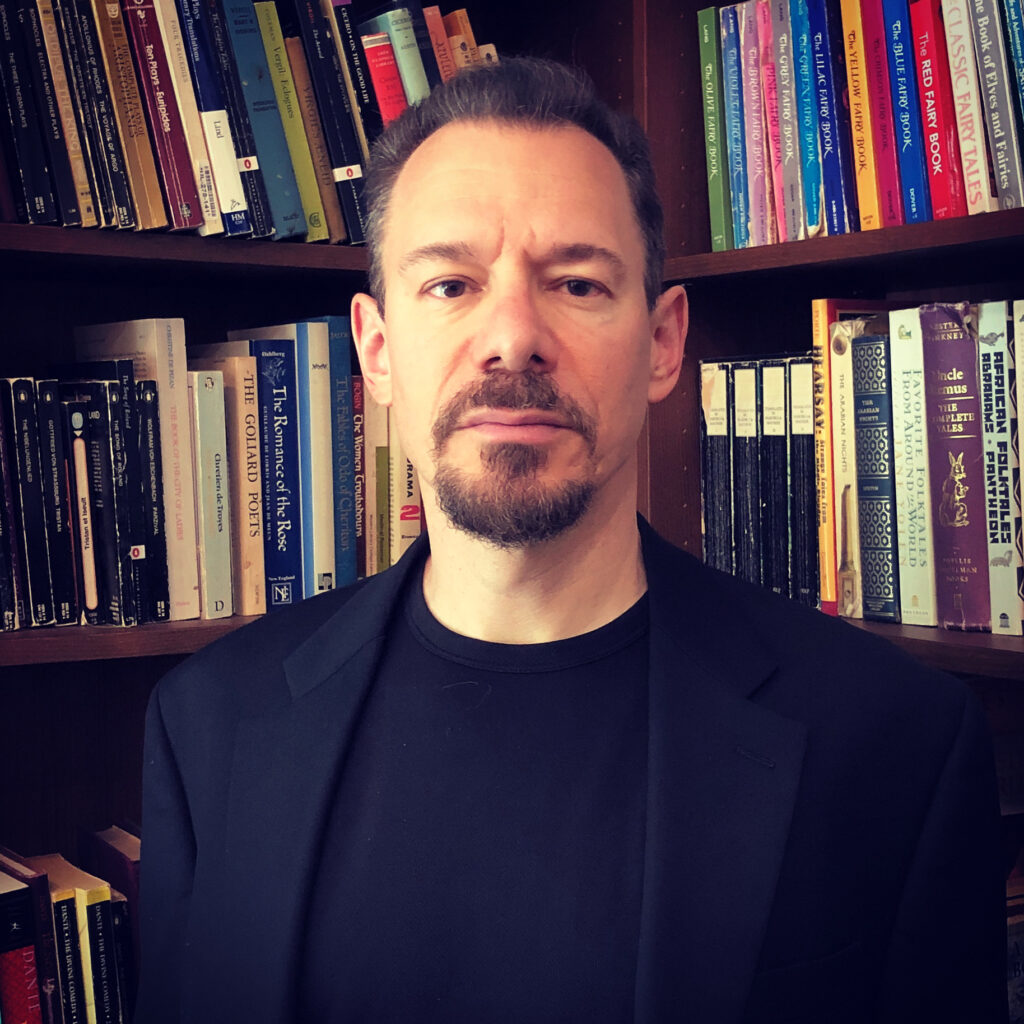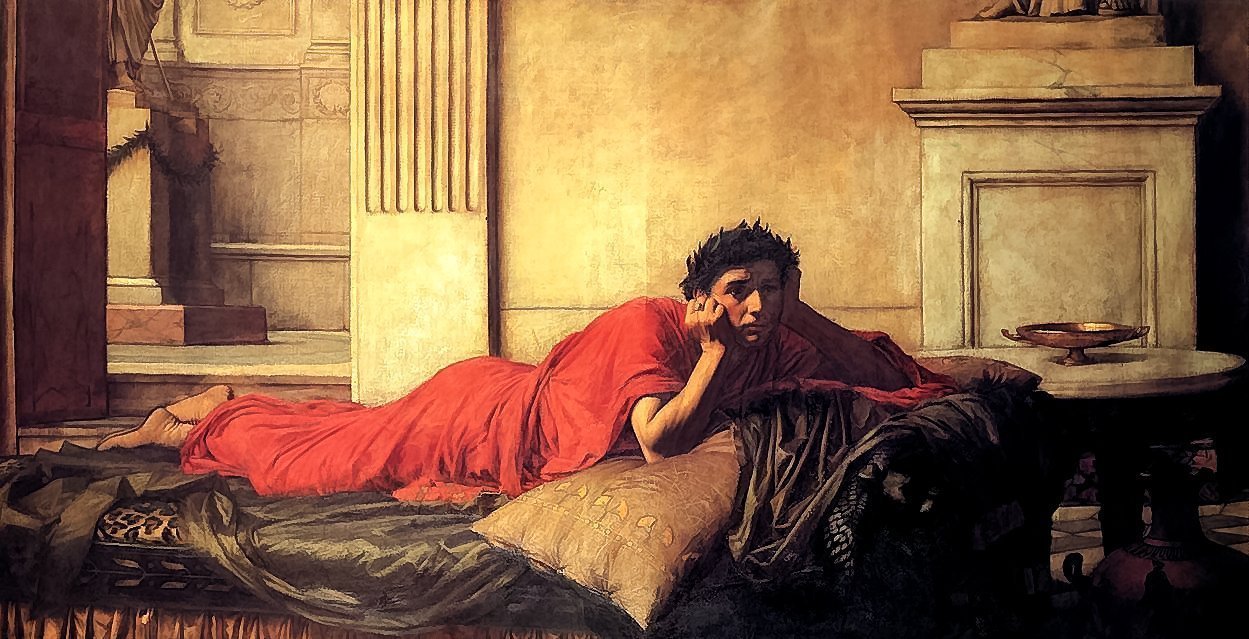Iconoclasm, the hatred and destruction of man-made images, is an old tendency in Abrahamic religions, emerging with violence in one century or another before submerging again.
The first and most prominent outbreak of iconoclasm within Christianity arose in the Eastern Roman Empire in the 8th century, at a time when the Empire was being sorely pressed, both militarily and culturally, by Islam. For complex reasons related in part to the struggle with Islam, the Emperor Leo III came to espouse iconoclasm and so banned religious icons throughout the Empire. The ban led to the widespread destruction of icons and persecution of Christians who venerated them. The persecution led leading figures in the Church, such as St. John of Damascus, to reflect upon and articulate the theology of icons. St. John defended the veneration of man-made icons as earthly things that signify and raise the soul to divine things, expressly appealing to the poetics of Scripture by analogy.[1] After several decades of debate within the Empire, the Second Council of Nicaea (787) met, doctrinally approved the veneration of icons,[2] and condemned iconoclasm as heresy.[3] This council was received by both East and West as the Seventh Ecumenical Council. St. John of Damascus came to be recognized as a Church Father and, in the West, a Doctor of the Church. St. Thomas Aquinas held him in especially high esteem, citing him 367 times in the Summa Theologiae. There is a harmony between St. John’s theology of icons and St. Thomas’ theology of spiritual senses in sacred doctrine: in both cases, man-made things that depict the works of God can signify divine things.
There are poetic icons as well as painted ones. (Here, we take ‘poetry’ in its ancient sense of ποίησις to include all making or producing, with an emphasis on literary work as the case of particular interest.) The Church Fathers created many such poetic icons, following the poetics of Scripture even more closely than do painted icons. St. Gregory of Nyssa’s Life of Moses is an excellent example. The tradition of iconographic poetry continued well into the early modern period, as exemplified by St. John of the Cross’ Spiritual Canticle. Here, as always, the affirmation creates the possibility of its negation: Just as there is a heretical iconoclasm directed at painted icons, there is an analogous poetic iconoclasm that harbors a deep suspicion of human literature that strives to convey the light of God.

Patrick Downey’s Serious Comedy was published originally in 2000 by Lexington Books and recently reissued by Davenant Press in a second edition with a new preface by the author and a new foreword by Colin Redemer. It is a wide-ranging, interesting, and deeply challenging work of enduring relevance that critically engages with central questions of political philosophy and theology and is therefore worthy of its republication. The book considers and offers interpretations of a broad swath of Western poetics: Greek comedy and tragedy; their treatment by Plato, Aristotle, and René Girard; the Bible; and subsequent authors, including Dante, Machiavelli, Hegel, Nietzsche, and Kierkegaard. The book is also, at root, a work of poetic iconoclasm. Although the entire work is worthy of engagement, we will focus chiefly on Downey’s account of poetics and his application of it to Aquinas and especially Dante, whom Downey takes to be pivotal for his reading of modern authors.
Downey argues that there is a fundamental antithesis within poetry between comedy and tragedy, and that comedy further divides into several modes, depending on the relation implied in a work between the author and the reader. He takes these distinctions to be of critical importance for philosophy, theology, and the course of Western thought. Deploying these distinctions, Downey advances a set of interlinked theses: Plato’s quarrel in the Republic is not with poetry in general but with tragedy in particular; the writings of Plato and Aristotle are themselves comedies, but of a playful sort, pointing to a pursuit of truth that takes place off the page, unlike tragedy which is politically “serious;” Scripture is comedy, but of a serious sort, conveying truth on the page; Scripture, like Plato, is opposed to tragedy; modern thought began with comedy, although of a new type infused with the political aspirations of tragedy; modern thought turned to tragedy outright from Hegel onward; theology and philosophy, in order to be oriented to truth, must return with sincerity to comedy.
Downey’s Poetics
Downey proposes that the antithesis between tragedy and comedy serves as the hermeneutic key to the various “quarrels” beloved of Straussians, including those of poetry and philosophy, Athens and Jerusalem, and the Ancients and Moderns. Drawing on René Girard,[4] Downey depicts the tragic poets as deceivers who conceal founding acts of political violence under the mystification of “fate” or the “will of the gods.” Tragedy is inherently political and achieves its psychological and social effects through a collective lie. In its narrative depiction of the scapegoat (φαρμακός), tragedy serves both as drug and poison (φάρμακον), reconciling citizens to the city, but only by deceiving them about the city’s true nature.
Comedy, in contrast, is not political in this foundational sense. Rather, it is “subpolitical” in acting chiefly on the individual. This foundational difference leads to several others. Tragedy affects a grave but false realism, while comedy “winks at the audience” and acknowledges its own artifice. Tragedy, in its deception, leads the audience away from θεωρία, the vision and contemplation of the good, while comedy can sometimes lead toward it. In Straussian terms, tragedy attempts to supply “knowledge of the whole” by fictitiously constructing it, whereas classical comedy only points to “the whole” without pretending to supply it.
Downey identifies Plato’s critique of poetry with his own. As noted, Downey proposes that Plato’s quarrel is not with poetry in general but with tragedy in particular. In fact, Plato’s dialogues are themselves comedies of a philosophic sort that direct the reader away from the works of human hands, including themselves, toward the life of inquiry outside the page. This particular aspect of Plato is his “essential difference” from the moderns: “Plato chooses to write comically and so make manifest the deceptive qualities of writing, whereas the moderns write seriously and so openly embrace, even while still covering over, the deceptive means of tragedy for the founding of society.”[5] Scripture likewise is comedy and fundamentally hostile towards tragedy as a kind of idolatry. Yet, there is a crucial distinction between these two positive exemplars of comedy: whereas Plato’s philosophical comedy directs one away from writing to θεωρία, the Scriptural comedy directs one further into its own written word toward God.
Tragedy and Comedy Reconsidered
In considering the claim of a radical opposition between tragedy and comedy, we find prima facie reasons to suspect that the two forms of drama, however importantly distinct, have a more subtle relation. First, tragedy and comedy were presented in classical Athens at one and the same religious festival, the Διονύσια τὰ ἐν Ἄστει. Second, Aristotle in the Poetics traces the primordial roots of both forms to one and the same author, namely Homer (Poetics 1448b). These considerations, while hardly dispositive, are sufficient to encourage us to explore an alternate view, namely that tragedy and comedy are not antithetical, but one is often a ‘moment’ within the other. The reversal (περιπέτεια) is central to both.[6] Downey takes this common element to function in incompatible ways in tragedy and comedy,[7] but in fact it allows the one form to be embedded within the other, a technique employed repeatedly by Shakespeare. In this view, the tragic and the comic, rather than antagonistic genres, are features of poetry that can co-occur in a single work.
When we carefully read the dialogues of Plato, we find much to support this perspective. It is true, as Straussians love to recount, that Socrates speaks in one place of “an ancient quarrel between philosophy and poetry.” However, in that very passage (Republic 10.607b-c), Socrates describes that opposition as being chiefly on the part of the poets, not part of any philosopher’s critique of poetry, much less of tragedy in particular. The Athenian Stranger in the Laws confirms that the quarrel was prosecuted by the poets, not the philosophers, explaining that the poets were offended by the naturalistic cosmologies of the Pre-Socratics (Laws 12.967c). When Plato expressly treats of the relation between tragedy and comedy, we find Socrates arguing that the roles of tragedian and comedian are compatible, “that the fully skilled tragedian could be a comedian as well” (Symposium 223d). Socrates elsewhere goes further and argues not merely for a unity of the roles of tragedian and comedian but for a unity of the contents of tragedy and comedy (Philebus 50b), grounding that unity in human nature itself, as grasped by philosophy (Philebus 50d).
In turning to Christian Scripture, Downey reads it as a narrative whole, one that is fundamentally a comedy and hostile to tragedy. We concur with the comic nature of Scripture, taken as a narrative whole, but insist on a moment of tragedy at its very center. The sacrificial death of the hero, the tragic pattern par excellence, is found in its fullest expression in the passion and death of Christ. If the Gospels are the heart of Christian Scripture, then the events of Holy Week are the heart of the Gospels, and the Triduum of Holy Thursday, Good Friday, and Holy Saturday stands as a monumental tragedy within them. While Easter Sunday renders the whole a comedy, it in no way excises the Triduum. In contrast, Downey wants to strongly minimize the tragic dimension of the Passion in favor of comedy: “Christ’s tragic crucifixion is … tragic only in isolation––as isolated from the entire narrative” authored by the divine “comic narrator of a comic narrative.”[8] The same pattern of embedding recurs in the Book of Revelation in its recapitulation of the whole of Scripture. The bulk of the book is an intense tragedy of desolating violence, encompassing pestilence, warfare, famine (Rev. 6), persecution (Rev. 7), physical calamity (Rev. 8), plague (Rev. 9), and spiritual derangement (Rev. 13), all in repeated, escalating waves (Rev. 14-19), until it resolves finally in triumphant comedy (Rev. 20-22). Downey attends only to this comic resolution, glossing the book as “a proleptic capstone to the entire plot that had its beginning in Genesis” and so “demonstrates decisively that the Bible is a comic plot, and thus a plot that must tie up all loose ends and reinstate the true natural goodness of all things declared at the very beginning.”[9]
Downey on Dante
Central to Downey’s position is his judgment that poetry consists of lies. The “poet is precisely he who stands between us and true reality.”[10] So sharp is the distinction “between what a poet does when he makes a world” and reality that “all human making is a lie except God’s own making in Scripture.”[11] Downey applies this poetics of the lie to Dante, sharply contrasting his comments on poetry in two sources, the Convivio and his letter to Can Grande.
In the Convivio, Dante briefly remarks on the allegorical sense of writing: “theologians take this sense otherwise than do the poets; but since it is my intention here to follow the method of the poets, I shall take the allegorical sense according to the usage of the poets.”[12] Downey develops this remark into a distinction between two genres: an “allegory of the poets,” based on lies, and an “allegory of the theologians,” equating the former to “generic comedy” and the latter to the “specific comedy of Scripture.”[13]
For Downey, the fact that generic comedy is based on lies, known by the reader as such, critically undermines the power of its allegory. “One of the key problems facing all generic comedies when it comes to taking their allegorical meanings seriously is the obvious fact that the very beauty of their lies casts doubt upon the truth of their meanings.”[14] This weakness of generic comedies is part of what makes them subpolitical, rendering “them much less politically effective than tragedy” and making “them useless as a foundation for any sort of lasting political achievement.”[15]
The political weakness of generic comedy leads Downey to the hidden truth about Dante: the poet composed his lengthy work on the afterlife as an esoteric project in pursuit of political power. Leo Strauss argues that, in the “quarrel between the ancients and the moderns,” it is Machiavelli who makes the fundamental break with the former, thereby giving rise to the latter.[16] Downey offers the novel argument that it is not Machiavelli but his fellow Florentine, Dante, who makes this break, with Machiavelli following in his wake 200 years later. Dante performs this remarkable feat by subtly contravening Aquinas’ account of the poetics of Scripture, “conflating his own poetic role with that of God.”[17]
Downey discerns the signs of this contravention in Dante’s letter to Can Grande. Downey takes Dante’s poetics in the letter to be “startlingly different”[18] from that of the Convivio in two regards. On the one hand, the letter is closely modeled on Aquinas’ account of the four senses of Scripture; on the other hand, the letter’s account contains “no mention of what is all important in Aquinas’, the complete dependence of the three spiritual senses upon the authorship of God.”[19]
Through this deceptive equivocation, Dante lies twice over: he lies first in his poem, then lies about his lies in his poetics. By doing so, he seeks to write an “allegory of the poets” but have it read as an “allegory of the theologians” for the sake of political power. “Dante is single-handedly trying to prepare the way for his own comedy, … deliberately fudging the distinction between generic comedy and the specific comedy of Scripture in order to give his own Commedia the political power of the latter.”[20]
A Startling Difference?
A reading of the Convivio and the letter to Can Grande shows no “startling difference” between their poetics. The Convivio itself treats of all four senses, using language for the spiritual senses very close to that of the letter to Can Grande, to the extent of using the same verse from Scripture as illustration.[21] Dante is unambiguous in the Convivio that he is applying spiritual interpretations to his own poetry (canzone) contained in the work itself: “I shall on each occasion discuss first the literal meaning concerning each canzone, and afterwards I shall discuss its allegory (that is, hidden truth), at times touching on the other senses, when opportune.”[22]
Nor is there a contrast between an “allegory of the poets,” based on falsehoods, and an “allegory of the theologians,” based on the unique truths of Scripture. The passage that Downey cites, quoted above, does not use these phrases and does not propose two genres of allegory, but merely notes that “the theologians take this sense otherwise than do the poets.” The different usages of poets and theologians to which Dante refers depends not on whether the literal sense is true, but on the potential scope of the allegorical sense. For theologians interpreting Scripture, the allegorical sense has a narrower scope wherein “the things of the Old Law signify the things of the New Law.”[23] For poets, the potential scope is wider, including philosophic truths.
Dante does not hold that his poetic allegories are based on lies, as shown by his detailed explanation of the need to first interpret the literal sense of his canzone, which he takes to be true, before proceeding to any allegory.[24] In book 2, for example, his literal interpretations center on astronomy and other instances of natural philosophy. He makes no sharp departure when, in his letter to Can Grande, he later proposes to apply spiritual interpretations to the Commedia, as we will explore further below.
Truthful Fiction
It is salutary to consider a different approach in which fiction consists not of lies but of imaginative constructs that are truthful in a way proper to the genre. A lie consists of a falsehood uttered with intent to deceive.[25] Fictional literature, acknowledged as such, has no such intent. While it deals with persons and events that are imaginary in some degree, these things are not usually intended to deceive; they are not even false, in the ordinary sense of the term. Nor is it the case that the power of a literary work, including whatever allegorical senses it may have, is undermined by the awareness that it is fiction. Countless readers have been deeply moved, sometimes in life-changing ways, by reading Persuasion or The Brothers Karamazov, unimpeded by the knowledge that these are works of fiction.
The images of fiction work, not by falsehood or deception, but by a connection to reality that reflects a genuine verisimilitude: namely, an ensemble of properties that fits in a revelatory way the kind of thing depicted. The world consists of real things that appear to us, often mediated by man-made images. When looking through a telescope or at the display of a security camera, one sees images that truthfully reveal things. The images of fiction can likewise reveal truths, although by a certain indirection. Literary fiction and nonfiction certainly differ, but not as radically as Downey would have it.
The words of nonfiction, even those we might consider the most truthful, are not themselves the events and persons they represent but images thereof. Socrates is at pains to draw out this point in his critique of writing in the Phaedrus. The written word is fixed and requires a reader to revivify and interpret it (Phaedrus 275-276). Understanding this dynamic full well, Plato nevertheless chooses to write, for the images that might deceive can also serves as icons of the good.
Poets act likewise, practicing a fundamental human art. Good poetry is a humanly constructed part of the one world; it does not constitute a separate false world, as in a gnostic interpretation. This understanding is a basic presupposition of a poetics such as Tolkien’s. In “On Fairy-Stories,” Tolkien articulates an approach to fiction as “sub-creation,” in which human poesis is both an analogy with and a worthy participation in divine creation,[26] which closely describes Dante’s approach as well.
Aquinas on the Spiritual Senses
Downey reads Aquinas as claiming that only Scripture can have spiritual senses. From the fact that the spiritual senses rest on “the power of adapting ‘things themselves’ to convey meaning, a power that is reserved to God alone,” Downey infers that the “‘specialness’ of Scripture is thus the specific qualities of its poet, and those qualities are the unique qualities of the poetic maker of the world who alone can fit things-to-things together in the world.”[27]
Is it true that Dante contravenes Aquinas’ account? A careful reading of the relevant article of Summa Theologiae[28] suggests otherwise. Aquinas does say that Scripture can have spiritual senses because its author is God, “in whose power it is to signify his meaning, not by words only (as man also can do), but also by things themselves,” and “that signification whereby things signified by words have themselves also a signification is called the spiritual sense.”[29] In other words, while man commonly signifies by words, God also signifies by things, which is made possible because things in the world (e.g., events, institutions, or persons) are brought about by divine providence. Aquinas explains that signification by things is distinctive of what he calls “sacred doctrine.”[30] For Aquinas, sacred doctrine is not synonymous with Scripture. Rather, it is a science,[31] indeed, a speculative[32] science that proceeds by argumentation from the articles of faith.[33] The interpretation of Scripture is an application of this science but does not exhaust it. This distinction is critical for grasping the manner in which Downey has misread Aquinas.
While Aquinas uses many of the same words as Downey,[34] nowhere does he say that only Scripture can have spiritual senses. The latter is a mistaken inference on Downey’s part. The relevant act of God is in bringing about the events, institutions, or persons referenced in sacred doctrine, not in recording them in Scripture. Once these things are brought about by God, there is nothing to prevent human authors from referring to these things with words and bringing out their spiritual senses in writings outside of Scripture. When subsequent theological authors write of the works of God, they too may bring out their spiritual senses. The possibility of having a spiritual sense lies in the divine authorship of things, not in the writings by which we learn of them. Nor is this possibility limited to the things recorded in Scripture. If God is the author of history, then any historical event, institution, or person, and not only those referenced in Scripture, can potentially have spiritual senses.
Dante Re-examined
Aquinas’ reference to sacred doctrine as a science[35] makes clear that he intends his poetics to apply to texts that we would today call nonfiction. In particular, his teaching that the spiritual senses depend on the divine authorship of things presupposes that the latter are things in the world to which a nonfictional text may refer. How fiction should be interpreted is a topic Aquinas does not address, as it is outside the scope of sacred doctrine. Nevertheless, it is clear that in fiction the literal sense of words refers to things in the narrative,[36] of which the poet is himself the author. While these things may not strictly admit of spiritual senses, the full range of poetic tropes, including typology, is nonetheless available. It is quite common for a poem to include both fictional and nonfictional persons and events; this combination poses no great problem.Even in Scripture, not every person or event mentioned has a spiritual sense; many things are interpreted according to their literal sense alone. (This fact is less restrictive than it might seem given that, for Aquinas, the literal sense encompasses all the ordinary poetic tropes.[37]) While the fictional things in a poem must be interpreted according to ordinary poetics, nothing precludes the nonfictional things in the same poem from having a spiritual sense. Hence, when Dante, drawing on examples from Scripture, explains that he intends the Commedia to be interpreted in accordance with the spiritual senses,[38] this intention in no way contravenes Aquinas’ poetics. The reader understands that the poem contains many fictional elements, and not all its elements will have a spiritual sense.
Downey accuses Dante of the deceptive “ruse” of “realism,” that is, of writing in a manner that gives the appearance of reality when in fact it is not. Such “realistic” writing is far from neutral for Downey: by writing in this manner, Dante “assimilated to himself the world-making powers of the Christian God.”[39] This objection can hardly be limited to Dante but rather implicates fiction itself. As one point of comparison, consider C. S. Lewis’ The Great Divorce.[40] Lewis’ work, while differing greatly from the Commedia in size and scope, is quite close to it in presenting an imaginative treatment of the afterlife, perhaps even to include the author appearing in his own work. (Although not named, it is fairly clear that Lewis himself is intended to be the narrator; he meets George McDonald as his guide, as Lewis felt him to be in life.) It follows from Downey’s critique that Lewis and similar authors should be condemned along with Dante for the offense of “realism.” Downey illustrates Dante’s offense by noting that the poet supplies an inscription upon the gates of hell, attributing their construction to the justice, wisdom, and love of God (Inferno, Canto III). Downey disapprovingly notes the fact that “this gate with its writing is nowhere found in Scripture.”[41] (The gates of hell are referred to by Jesus in Matthew 16:18.) By supplying the inscription, Dante has deceptively “conflated his own poetic role with that of God,” giving unheard of “powers to the comic poet.”[42]
Conclusion
After examining the evidence, one would be justified in harboring a deep skepticism toward Downey’s claim, which he acknowledges to be “highly eccentric,”[43] that Dante’s poetry was motived by a pursuit of political power through esoteric means. Downey’s greatest concern, however, is not political but theological; more precisely, it lies at the intersection of theology and poetics, and takes the form we identified earlier as poetic iconoclasm. In the end, Downey deems poesis, as Dante and others engage in it, to be not only a lie but a kind of murder of God: “Once we forget that making is not knowing, that we live in a world wherein all human making is a lie except God’s own making in Scripture, then we ourselves have killed the God of Creation and Scripture through a violent act of usurpation.”[44] This poetic orientation entails a great danger of “denigration and hostility to the creator” at the heart of humanistic education, particularly for the “graduate of a Catholic liberal arts college.”[45] Downey’s poetic iconoclasm is grounded not merely in fear of moral offense but in a ressentiment directed toward beauty in art. He conveys an envy of Dante on behalf of the human biblical “authors who poetically expressed their religious experience through their beautiful, but––admit it––not nearly as beautiful, poetry as Dante’s.”[46]
For our part, we stand unreservedly on the side of τὸ καλόν, in poetry and in life, and deem it no offense to God but a reflection of his glory. To the fear and ressentiment of poetic iconoclasm, we would counterpose the brave and gracious spirit of Hopkins:
I say more–– the just man justices
Keeps grace, that keeps all his goings graces,
Acts in God’s eye what in God’s eye he is––
Christ–– for Christ plays in ten thousand places
Lovely in limbs, and lovely in eyes not His,
To the Father through the features of men’s faces.[47]
[1] St. John of Damascus, Three Treatises on the Divine Images, trans. Andrew Louth (Crestwood, NY: St. Vladimir’s Seminary Press, 2003).
[2] Heinrich Denzinger, The Sources of Catholic Dogma, trans. Roy J. Deferrari (St. Louis, MO: B. Herder Book Co., 1957), DS 302 (hereafter cited as DS).
[3] DS 304.
[4] René Girard, Violence and the Sacred, trans. Patrick Gregory, (Baltimore and London: The Johns Hopkins University Press, 1979).
[5] Downey, Serious Comedy, 153.
[6] Roger W. Herzel, “‘Anagnorisis’ and ‘Peripeteia’ in Comedy,” Educational Theatre Journal 26, no. 4 (December 1974): 495-505.
[7] Downey, Serious Comedy, 192-7.
[8] Ibid., 225-6. Girard’s interpretation of the Passion also contrasts with Downey’s. Downey discusses Girard at length in Part One of Serious Comedy, concerning the Greeks, but does not mention Girard at all in Part Two, concerning Scripture. Girard holds that the Passion is a culmination of tragedy that unmasks the mythological structure of the scapegoat mechanism by exposing the innocence of the scapegoat. See René Girard, The Scapegoat (Baltimore, MD: The Johns Hopkins University Press, 1986).
[9] Downey, Serious Comedy, 264.
[10] Patrick Downey, “Dante, Aquinas, and the Roots of the Modern Aesthetization of Reality,” in Beauty, Art, and the Polis, ed. Alice Ramos (Washington, DC: American Maritain Association, 2000), pp. 94.
[11] Ibid.
[12] Dante Alighieri, Il Convivio (The Banquet) (Garland Library of Medieval Literature, 1990) 2.1, accessed December 28, 2022, https://digitaldante.columbia.edu/text/library/the-convivio/.
[13] Downey, Serious Comedy, 323.
[14] Ibid.
[15] Ibid.
[16] Leo Strauss, Thoughts on Machiavelli (Chicago: University of Chicago Press, 1958).
[17] Downey, Serious Comedy, 326.
[18] Ibid., 323.
[19] Ibid., 324.
[20] Ibid., 326.
[21] Dante Alighieri, Letter to Can Grande, accessed November 13, 2022, http://medieval.ucdavis.edu/20B/Can.Grande.html.; Dante, Il Convivio 2.1. The verse is Ps. 113:1-2 of the Vulgate.
[22] Dante, Il Convivio 2.1.
[23] ST I, q. 1, a. 10, resp.
[24] Dante, Il Convivio 2.1.
[25] ST II-II, q.110, a. 1, s.c.
[26] J. R. R. Tolkien, “On Fairy-Stories,” in The Tolkien Reader (New York: Ballantine Books, 1966).
[27] Downey, Serious Comedy, 312.
[28] Summa Theologiae I, q. 1, a. 10 (hereafter ST).
[29] ST I, q. 1, a. 10, resp.
[30] Ibid.
[31] ST I, q. 1, a. 2, resp.
[32] ST I, q. 1, a. 4, s.c.
[33] ST I, q. 1, a. 8, resp.
[34] Downey, Serious Comedy, 310-311.
[35] ST I, q. 1, a. 2, resp.
[36] These things in the fictive narrative may or may not also be in the world, i.e., real. One need only consider carefully researched historical fiction to see that they can sometimes be real.
[37] ST I, q. 1, a. 10, ad. 3.
[38] Dante, Letter.
[39] Downey, Serious Comedy, 328.
[40] C. S. Lewis, The Great Divorce (New York: HarperCollins, 2001).
[41] Downey, Serious Comedy, 326.
[42] Ibid.
[43] Ibid., 325.
[44] Downey, “Dante,” 94.
[45] Ibid.
[46] Ibid, 95.
[47] Gerard Manley Hopkins, “As Kingfishers Catch Fire,” in Poems and Prose of Gerard Manley Hopkins (London: Penguin Books, 1953), pg. 51.

Stephen Pimentel is an engineer in the San Francisco Bay Area working in crypto and machine learning. He is interested in classics, political philosophy, and governance futurism. He can be reached on Twitter at @StephenPiment.




